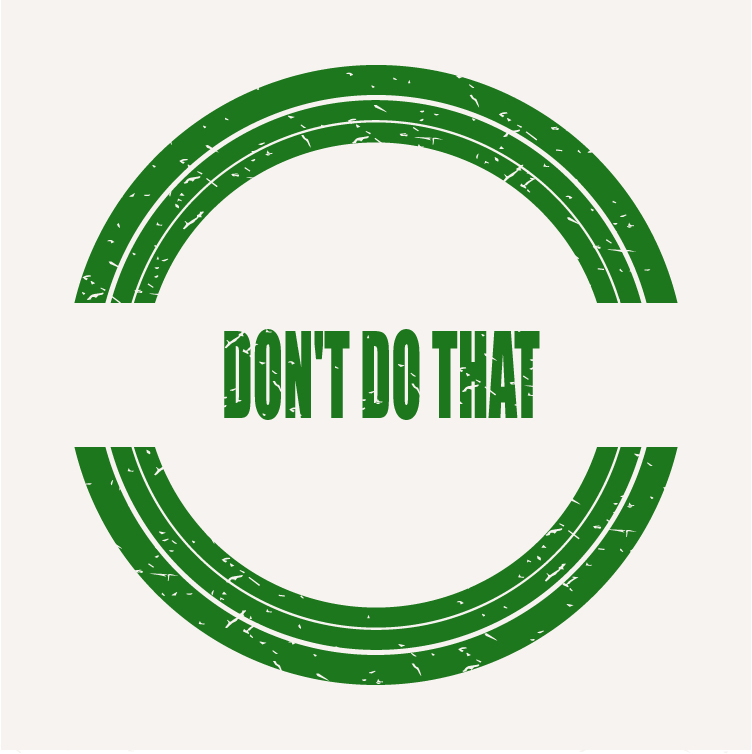Don’t do that

A widely held belief among health care professionals is that it is a waste oftime to recommend to an injured runner to stop running. The assumptionis a dedicated runner will not follow recommendation of “don’t do that”.
With a few exceptions most injured runners do not need to be told “don’trun”. The exception is a stress fracture, this injury requires stopping running.Injured runners do need to change the degree or manner of running.Most injured runners can continue to run and still recover from the injury.Cross training provides opportunity for decreasing the amount of runningwhile substituting alternative forms of exercise in order to fulfillpsychological needs and continuing physiological conditioning.
There are other things an injured runners needs to stop doing in order torecover from an injury. Some postures and movements may not result inimmediate pain, but when performed repeatedly over time contribute topain problems. Repeated movements and postures that are performed inthe same direction during daily activities such as working, sitting, andstanding can result in an accumulation of stress to tissues resulting in injury.Running becomes the preverbal “straw that broke the camels back”.
Examples:
Sitting on your foot with one foot tucked underneath the opposite leg withthe heel of the shoe pressing directly into the buttock region can lead topain in the buttock (priformis syndrome). Short females often sit this waybecause chairs are too tall and feet don’t reach the floor. Usually this isnot a balanced activity; one foot is tucked much more frequently thanthe other because of habits related to hand dominance. Using a footstool can often assist in modifying this harmful sitting posture. Bothpirformis muscles are used running, but the one subjected to directcompression from the heel of a shoe will experience pain when running.
Short people sitting in a chair which is too large for their stature will oftenposition the foot in a “tip toe” position with the other foot crossed behindthe foot that is contacting the ground. This leads to a concentratedpressure on the ball of the foot, and the toes being bent to an extremeposition, much like wearing high heel shoes. Pain in the ball of the footmay not be noticeable when sitting, but becomes very apparent whenrunning. Selecting chairs that are closer to the floor or using a foot stoolhelps.
A patient who complained of knee pain when running, presented as tallslender shy male teenager who frequently sat with his right leg crossedover the left leg and the right leg wrapped around behind the left lowerleg with the right foot twisted outward. The legs appeared much like apretzel. His alignment when standing, walking, and running the right lowerleg was in an outward rotated position. The knee pain was alleviated byavoiding sitting in a twisted position and consciously modifying hisstanding, walking, and running form by rotating the lower leg inward.
A patient whose favorite sitting position was with the left foot/ankle restingon the right knee in what is commonly called the “tailors position”complained of left arch/heel pain when running. Because the left footwas unsupported when sitting in this position the foot would hangdownward. This resulted in an asymmetrical alignment that the left footwas rotated outward in a “duck position”. The problem resolved byavoiding sitting in this habitual asymmetrical position in combination withactively bringing his left foot inward when walking and running.
Right handed mothers often carry their child perched on the left hip forsignificant amounts of time standing with a majority of the mother’s andchild weight on the left leg. This leads to changes in the muscle lengthand strength about the low back, pelvis and hip. Subjecting this poorlybalanced spine and pelvis to running can lead to back, hip, knee, footpain.
When wearing a dress ladies keep their knees together. Keeping theknees together when getting out of or into a chair can place abnormalstresses on the knees. Rising out of a chair may not hurt but if you run withyour knees together it will hurt.
These are few examples of the way everyday habitual activities areperformed can contribute to the development of repetitive use injuries.Identifying these harmful everyday activities may be simple, but oftenrequire a thorough Physical Therapy evaluation and examination in orderto correlate observed joint alignments, movements, and the manneractivities/postures are done with recurring injury. If these everydayactivities are not identified and modified the prognosis for recovery fromrecurring injury is poor. Often the best treatment recommendation is“Don’t Do That”.
Damien Howell Physical Therapy – 804-647-9499 – Fax: 866-879-8591 At-Home, At Office, At Fitness Facility – I come to you, I do home visits Damien@damienhowellpt.com
